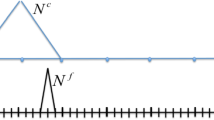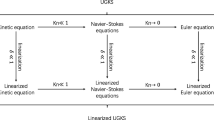Abstract
The coupling between the macro-scale numerical method and the molecular dynamics (MD) simulation is developed for simulating the micro- and nano-scale incompressible flow problems. The proposed coupling schemes are based on the technique of “domain decomposition” in which the MD simulation is used in the region where molecular details are important, while the macro-scale numerical method is used in the remaining bulk region. These two different descriptions are matched in an overlap region where we ensure the continuity of mass, momentum, energy, and their fluxes. Especially, in order to take full advantage of meshfree methods, the element-free Galerkin (EFG) method is adopted as the macro-scale numerical method and the variational multiscale method is introduced to overcome the numerical instabilities of the EFG method for solving the incompressible flow problems. Finally, we apply the coupling to solve the isothermal and non-isothermal Couette flow problems. The numerical results indicate that there is a good agreement between the results of the macro-scale numerical method and the results of the MD simulation in the overlap region. In addition, due to that the MD simulation is used in the region where the micro-effects are important, then we can simulate out the micro-scale effects in this crucial region.












Similar content being viewed by others
References
Belytschko T, Lu YY, Gu L (1994) Elementfree Galerkin methods. Int J Numer Methods Eng 37:229–256
Cui J, He GW, Qi DW (2006) A constrained particle dynamics for continuum-particle hybrid method in micro- and nano-fluidics. Acta Mech Sin 22:503–508
Flekkoy EG, Wagner G, Feder J (2000) Hybrid model for combined particle and continuum dynamics. Europhys Lett 52:271–276
Hadjiconstantinou NG, Patera AT (1997) Molecular dynamics-continuum representation for dense fluid systems. Int J Mod Phys C 8:967–976
Hu YX, Zhang XR, Wang WC (2010) Boundary conditions at the liquid-liquid interface in the presence of surfactants. J Am Chem Soc 26:10693–10702
Hughes TJR (1995) Multiscale phenomena: Green’s function, the Dirichlet-to-Neumann formulation, subgrid scale models, bubbles and the origins of stabilized methods. Comput Method Appl Math 127:387–401
Hughes TJR, Feijoo GR, Luca M, Jean-Baptiste Q (1998) The variational multiscale method—a paradigm for computational mechanics. Comput Method Appl Math 166:3–24
Khurram RA, Masud A (2006) A multiscale/stabilized formulation of the incompressible Navier-Stokes equations for moving boundary flows and fluid-structure interaction. Comput Mech 38:403–416
Liu GR, Gu YT (2005) An introduction to meshfree methods and their programming. Springer, Berlin
Liu WK, Chen YJ, Uras RA, Chang CT (1996) Generalized multiple scale reproducing kernel particle methods. Comput Method Appl Math 139:91–157
Liu WK, Harold SP, Dong Q, Eduard GK, Hiroshi K, Gregory JW (2006) Bridging scale methods for nanomechanics and materials. Comput Method Appl Math 195:1407–1421
Liu J, Chen SY, Nie XB, Robbins MO (2007) A continuum-atomistic simulation of heat transfer in micro- and nano-flows. J Comput Phys 227:279–291
Liu J, Chen SY, Nie XB, Robbins MO (2008) A continuum-atomistic multi-timescale algorithm for micro/nano flows. Commun Comput Phys 4:1279–1291
Nie XB, Chen SY, E WN, Robbins MO (2004) A continuum and molecular dynamics hybrid method for micro- and nano-fluid flow. J Fluid Mech 500:55–64
O’Connell ST, Thompson PA (1995) Molecular dynamics-continuum hybrid computations: a tool for studying complex fluid flows. Phys Rev E 52:5792–5795
Rabczuk T, Belytschko T (2004) Cracking particles: a simplified meshfree method for arbitrary evolving cracks. Int J Numer Methods Eng 61:2316–2343
Rabczuk T, Zi G (2007) A meshfree method based on the local partition of unity for cohesive cracks. Comput Mech 39:743–760
Rabczuk T, Gracie R, Song JH, Belytschko T (2010) Immersed particle method for fluid-structure interaction. Int J Numer Methods Eng 81:48–71
Sadus RJ (1999) Molecular simulation of fluids: theory algorithms and object-orientation. Elsevier, Amsterdam
Song JH, Belytschko T (2009) Multiscale aggregating discontinuities method for micro–macro failure of composites. Compos B 40:417–426
Soumyo R, Suman C (2007) Near-wall effects in micro scale Couette flow and heat transfer in the Maxwell-slip regimes. Microfluid Nanofluid 3:437–449
Wang Y, He G (2007) A dynamic coupling model for hybrid atomistic-continuum computations. Chem Eng Sci 62:3574–3579
Wang S, Liu H (2010) Modeling brittle-ductile failure transition with meshfree method. Int J Impact Eng 37:783–791
Wang H, Wang S (2008) Analysis of dynamic fracture with cohesive crack segment method. CMES 35:253–274
Xiao SP, Belytschko T (2004) A bridging domain method for coupling continua with molecular dynamics. Comput Method Appl Math 193:1645–1669
Yen TH, Soong CY, Tzeng PY (2007) Hybrid molecular dynamics-continuum simulation for nano/mesoscale channel flows. Microfluid Nanofluid 3:665–675
Zhang L, Ouyang J, Zhang XH (2008) On a multi-scale element-free Galerkin method for the Stokes problem. Appl Math Comput 203:745–753
Acknowledgments
The support from the Natural Sciences Foundation of China (NO. 10871159), the National Basic Research Program of China (NO. 2005CB321704) are fully acknowledged.
Author information
Authors and Affiliations
Corresponding author
Rights and permissions
About this article
Cite this article
Zhang, L., Ouyang, J. & Zhang, X. The coupling of element-free Galerkin method and molecular dynamics for the incompressible flow problems. Microfluid Nanofluid 10, 809–820 (2011). https://doi.org/10.1007/s10404-010-0711-3
Received:
Accepted:
Published:
Issue Date:
DOI: https://doi.org/10.1007/s10404-010-0711-3




